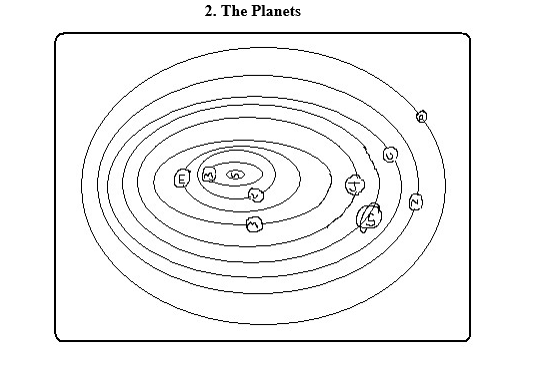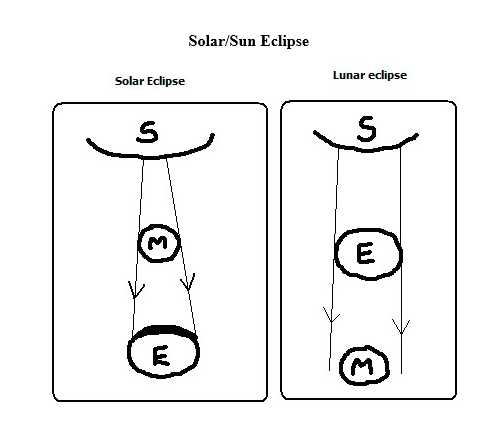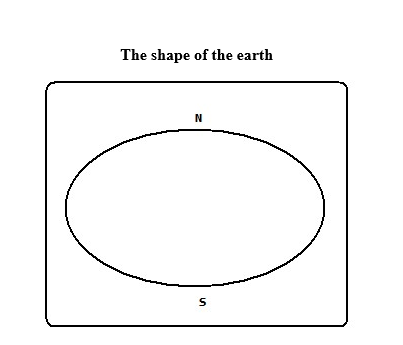Solar system is the group of heavenly bodies comprising the sun and the nine planets.
The origin of the Solar System Theories
A theory is a set of reasoned ideas intended to explain facts or events
1. Passing Star Theory
- A star with a greater gravitational pull passed near the sun
- It attracted large quantities of gaseous materials from the sun
- The materials split, cooled and condensed to form planets
- The planets were set in orbit by the passing star
Weaknesses
- Doesn’t explain the origin of the sun and star.
- Minimal chance of a star approaching another
- Materials would disperse than condense
2. Collision Theory
- Star with greater gravitational pull passed near the sun
- It attracted large quantities of gaseous materials
- The materials split into portions
- Large portions collided with smaller ones and swept them to form planets. The weaknesses are the same as the passing star’s Theory.
3. Nebula Cloud Theory
- There was a slowly rotating cloud of dust and gas called Nebula
- It cooled and began to contact
- Rotation speed increased and successive rings of gaseous materials were formed.
- The rings condensed to form planets
- The central gaseous material remained as the sun Evidence
- Rotation and revolution of planets in anticlockwise direction Weakness
The origin of nebular is not explained.
4. Supernova/explosion Theory
- There was a violent explosion of a star.
- A cloud of dust (nebular) remained from the star.
- There was fast movement of the cloud due to the force of explosion.
- Rotation speed increased due to gravitational attraction
- The cloud flattened into a disc.
- The matter began to accumulate towards the centre to form a proto-sun which later began to shine.
- The rest of the cloud collapsed to form planets.
Weaknesses
- Doesn’t explain the origin of the star
- Doesn’t explain the cause of explosion
Composition of the Solar System
1. The Sun
It’s the centre of the universe.
Characteristics
- It’s a star.
A star is a heavenly possessing its own light which it transmits.
Nebula/galaxy is a cluster of stars.
The earth is in a galaxy called The Milky Way.
- It’s made of very hot gases mainly hydrogen (70%) and helium (30%).
- Has a diameter of 1392000km.
- Surrounded by a layer of gas which has boiled from its surface which is called corona.
- Rotates on its own axis in anticlockwise direction.
- Has gravitational pull which holds all the planets in orbit around it.
An orbit is a path which a planet or a satellite follows around a star or a planet.
- Temperature at its centre is 15m◦c and at the surface is 5500◦c.
- Radiates solar energy which is very important for all forms of life on the earth.

Planets are large spherical celestial/heavenly bodies in space.
There are 9 planets in our solar system.
Characteristics
- Spherical in shape
- Don’t have their own light but reflect it from the sun.
- Revolve around the sun in anticlockwise direction.
- Have their own force of gravity
- Only one is known to support life.
The following are the planets arranged in order from the one nearest to the sun.
Mercury
- Nearest from the sun
- Its 58m km from the sun
- Has no satellites
- Takes approximately 88 earth days to revolve around the sun
Venus
- 2nd planet from the sun
- It’s 108m km from the sun
- One of the brightest planets
- Can be seen clearly with naked eyes
- Takes approximately 225 earth days to revolve around the sun
- Slightly smaller than the earth
- Has no satellites
- Together with the earth they are called twin planets due to having many similarities
Earth
- The 3rd planet from the sun
- The earth and the heavenly bodies make the universe
- The only planet that supports life
- The home of man
- Approximately 149m km from the sun
- Takes 365 ¼ days to revolve around the sun
- Has one satellite, the moon
Mars
- Also called The Red Planet because when it’s observed through a telescope it appears reddish.
- The 4th from the sun
- Slightly smaller than the earth
- Approximately 228m km from the sun
- Takes 687 earth days to revolve around the sun
- Between Mass and Jupiter there are small celestial bodies called planetoids.
- Has no satellite.
Jupiter
- 5th planet from the sun
- Approximately 778m km from the sun
- Largest in the universe
- Rotates on its own axis at very fast speed
- Has flattened poles due to its fast speed of rotation
- Has very thick layers of ice on its surface
- takes 12 earth years to revolve around the sun
- Has 16 satellites
Saturn
- 6th planet from the sun
- Second largest planet
- Approximately 1427m km from the sun
- Takes 29 ½ earth years to revolve around the sun
- Has a ring around it
- Has 18 satellites
Uranus
- 7th planet from the sun
- About 4 times bigger than the earth
- Approximately 2870m km from the sun
- Also rotates very fast
- Also has flattened poles due to fast speed of rotation
- It appears greenish foe being surrounded by methane gas
- Has 8 satellites
- Takes 84 earth years to revolve around the sun
Neptune
- One of the farthest from the sun
- 8th planet from the sun
- Approximately 4497m km from the sun
- Has 8 satellites
- Takes 165 earth years to revolve around the sun
- Very similar in size, colour and character with Uranus
Pluto
- 9th planet from the earth
- Farthest from the sun
- The smallest
- 1/6 the size of the earth
- Approximately 5900m km from the sun
- Takes 248 earth years to revolve around the sun
- Has one satellite
- Very little is known about it
Other Celestial Bodies Natural Satellites
Any natural heavenly body that orbits around a planet e.g. moon for earth, tritan for Saturn and Triton for Neptune.
Asteroids/Planetoids
- Also called minor planets.
- Are small fragments of rocks left going around the sun when the solar system was formed
- Found between Mass and Jupiter
- Are 1500 in number
- They sometimes collide with each other and planets due to Jupiter’s gravitational pull causing them to move in erratic orbits.
Comets
- Heavenly bodies which appear to have a head and a long tail
- Made of ice, dust and frozen gas
- The head is made of many particles of dust, rock and frozen gases. Their tail is made of gases and points away from the sun.
- Move around the sun in extremely long and oval orbits
- Their orbits cross the earth’s orbits e.g. Halley’s Comet which appears after every 76 years.
Meteoroid
- Small heavenly body which strays from its orbit in the solar system and enters the earth’s atmosphere at very high speed.
Meteor
- A meteoroid which is burning out due to friction after entering the earth’s atmosphere.
Meteorite
- Remains of a meteoroid which have reached the earth’s surface or incompletely burnt up meteoroid.
- When they fall they sink into the ground forming craters
- They are rich in iron
The Moon
- A natural satellite
- Receives its light from the sun and reflects it onto the earth.
- It revolves around the earth
- Takes 29.5 days to complete one revolution around the earth
- Its orbit is almost circular
- As it revolves around the sun it appears in various shapes ranging from crescent/new moon, half moon, gibbons moon and full moon.
- Has gravitational pull which causes the rising and falling of the ocean level
- As the moon orbits around the earth it creates an event called eclipse.
Eclipse
Phenomenon occurring when the rays of the sun are blocked from reaching the earth or the moon.

- The moon comes between the earth and the sun
- The moon’s shadow is cast on the earth
- The sun appears to be covered by darkness
Lunar/moon Eclipse
- The earth comes between the moon and the sun
- The earths shadow is cast on the moon
- The moon appears to be covered by darkness
The Origin of the earth
- A star with a greater gravitational pull passed near the sun
- It attracted large quantities of gaseous materials from the sun
- The materials split, cooled and condensed
- Heavier materials collected at the centre to form the core
- Less dense materials collected around the core to form the mantle
- The lightest materials formed the crust

The shape of the earth is called geoid/ovoid/oblate spheroid due to being an imperfect sphere by being wide at the equator and flat at the poles.
Proofs/Evidence That the Earth Is Spherical
- If one moves towards the east in a straight line he will end up where he started.
- Satellite photographs taken from space show that the earth is like a sphere.
- Places in the east see the sun earlier than those in the west.
- When a ship is approaching the smoke is seen first, then the mast and finally the whole ship.
- All the planets are spherical so the earth being one of them is also spherical.
- During the moon eclipse the earth casts a spherical shadow on the moon.
- The earth’s horizon appears curved when observed from a very high point like a tower.
The size of the earth
- Equatorial diameter-12756km
- Equatorial circumference-40085km
- Polar diameter-39995km
- Surface area of the earth-510×106 km2
- Water surface-73%.
The Movement of the Earth
There are 2 movements of the earth namely:
- Rotation of the earth on its axis
- Revolution of the earth around the sun
Rotation of the Earth
Movement of the earth on its own axis (imaginary line through the centre from N pole to S pole.
- Rotates through 360◦.
- Takes 24 hours (day) to complete 1 rotation.
- Rotates in an anticlockwise direction (west to east).
Effects of Rotation of the Earth
- Creates day and night because at any one time one side of the earth faces the sun (day) and the other remains in darkness (night).
- Causes deflection of winds and ocean currents in the N hemisphere to the left and in the S hemisphere to the right.
- It causes rising and falling of ocean tides.
- Causes time difference between longitudes.
- Takes one hour to go through 15◦.
- 4 min to go through 1◦.
Calculation of Local Time
The time recorded in places within the same longitude.
A longitude is an imaginary line running from N to S which shows how far E or W a place is from the prime meridian.
Greenwich Meridian (0◦) longitude is the point of reference when calculating time.
Time is gained towards the E and lost towards the W.
Examples
- Suppose the time at GWM is 12 noon what is the local time at Watamu 40◦E? Time gained=40×4=160min=2 hours 40min Local time at Watamu is 12.00+2.4
(Visited 3,096 times, 1 visits today)Share this:
